"Froissart's Little Things" and more
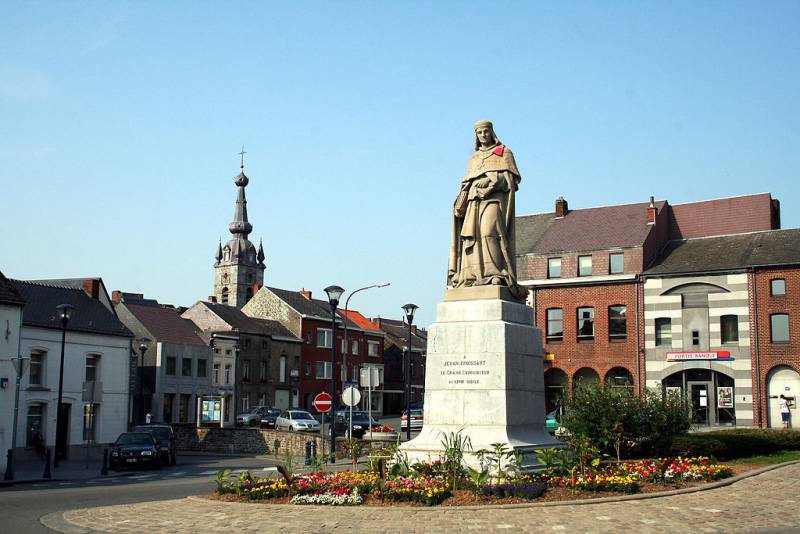
Statue of Jean Froissart in Chime (Hinaut province), Belgium
than many things with unrighteousness.
Book of Tobit, 12:8
Documents stories. In the previous material devoted to Froissart's four-volume book, we showed a number of miniatures from these books, concluding that these "pictures", for all their discrepancy between the dates of writing and description, are nevertheless an important historical source. But many VO readers, firstly, asked to tell more about the author of these "Chronicles", and secondly, to continue the "story by pictures", because they are very interesting, beautiful and informative.
It is difficult to object to this, so today we will continue our story about warriors and military affairs of the XIV-XV centuries. based on Froissart's miniatures (and not only him!), but most importantly, we will consider some fragments of his illustrations, magnifying them to the maximum. I am sure that in this way we will be able to see a lot of interesting things that the eye does not always notice in multi-figure illustrations.
But let's start with clarifying his biography.
Biography
He was born in 1333 or 1337 in Valenciennes, and died about 1405. Moreover, Froissart himself named for some reason two dates of his birth - 1333 and 1337. The first date was determined from the text in the Chronicle, where he wrote that in 1390 he was 57 years old.
It was only at the end of Book IV that he suddenly remembered that when he was present at the farewell of Queen Philippa and the Prince of Wales at Berkwemsted in 1361, he was 24. That is, his date of birth is different from the first - 1337. Apparently, he forgot or mixed up something.
He was a Walloon by birth and came from Valenciennes in Hainaut (Hennegau). It is believed that his father was a simple coat of arms craftsman, that is, he made coats of arms to order. Until 1359, Froissart was engaged in ... trade, but then he ended up in Prague and there he became a clerk at the court of King Charles IV of Luxembourg, where he met the legendary Petrarch, who at that time lived in Prague and was preparing to move to Venice.
At the age of 24, having secured the recommendation of Charles IV, who wrote about him as a court ... poet, he went to England and from 1361 to 1369 acted as a chronicler at the court of Queen Philippa, wife of King Edward III of England. All this time he traveled around Europe, visited France, and in 1367-1368. He also visited Italy, where he was with another famous person of his time - Geoffrey Chaucer.
When Philippa died in 1369, Froissart moved under the patronage of the Duchess of Brabant, Joanna, who gave him an estate in Hainaut. And the income from it turned out to be sufficient to travel in search of materials for the chronicles at his own expense.
But research - research, "chronicles" - "chronicles", but he also continued to write poetry. In 1395, Froissart returned to England, but he did not like it there. He discovered the decline of chivalry.
The exact date of his death is unknown. Just from a certain time, his name disappears from the documents.
Thumbnails
As we have already noted, his "Chronicles" consist of 4 books.
"Book I" is considered the most interesting. There are three main editions: the Amiens Manuscript, the A/B Family Manuscript, and the Roman Manuscript.
The first exists in only one list by an unknown copyist, and it was made around 1491. The “A/B Family Manuscript” is known in several dozen lists (!), and they are still not completely systematized. As for the "Roman Manuscript", it also survived in only one list. Until today, historians are only engaged in deciding which of the lists is the earliest and in what years it was written, but ... They never came to a consensus. However, for our purposes they are not essential.
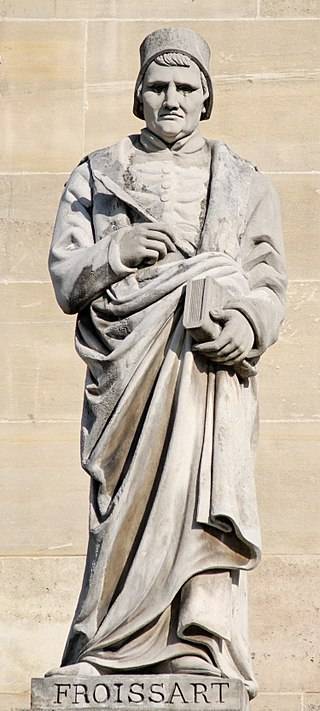
Froissart. Sculpture by Philippe Joseph Henri Lemaire (1798–1880), Louvre
But something else is important for us, namely: miniatures from these manuscripts, and we will not start with them, but with the work of Josephus Flavius in three volumes with illustrations. They were prepared for printing by William Whiston, and they were first published in 1667-1752.
What a Roman historian could write about is well known. He is the author of two works written in Greek - "The Jewish War" (about the uprising of 66-71 years) and "The Antiquities of the Jews". And what's funny, the text is about ancient history, but the armor, weapon and the design of the pages with a head give out the beginning of the XNUMXth century. And, by the way, the illustrations depicting all this are just great!
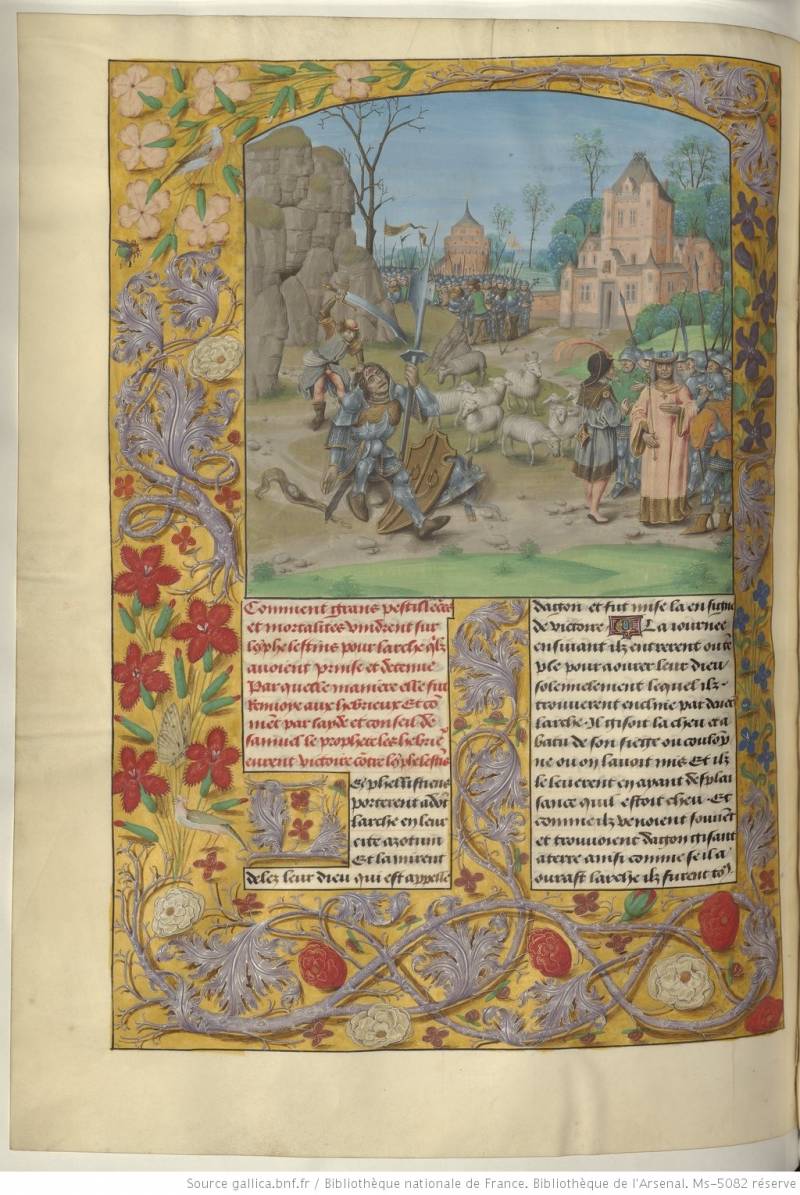
Scene from Antiquities of the Jews. Another version of David killing Goliath. He had already received a stone on the forehead, David had already thrown his sling, and now he swung his sword, and a very peculiar shape, to cut off his head. George Routledge & Sons, Ltd.; New York, E. P. Dutton & Co. Digitization sponsor Brigham Young University. Contributor Harold B. Lee Library. National Library of France
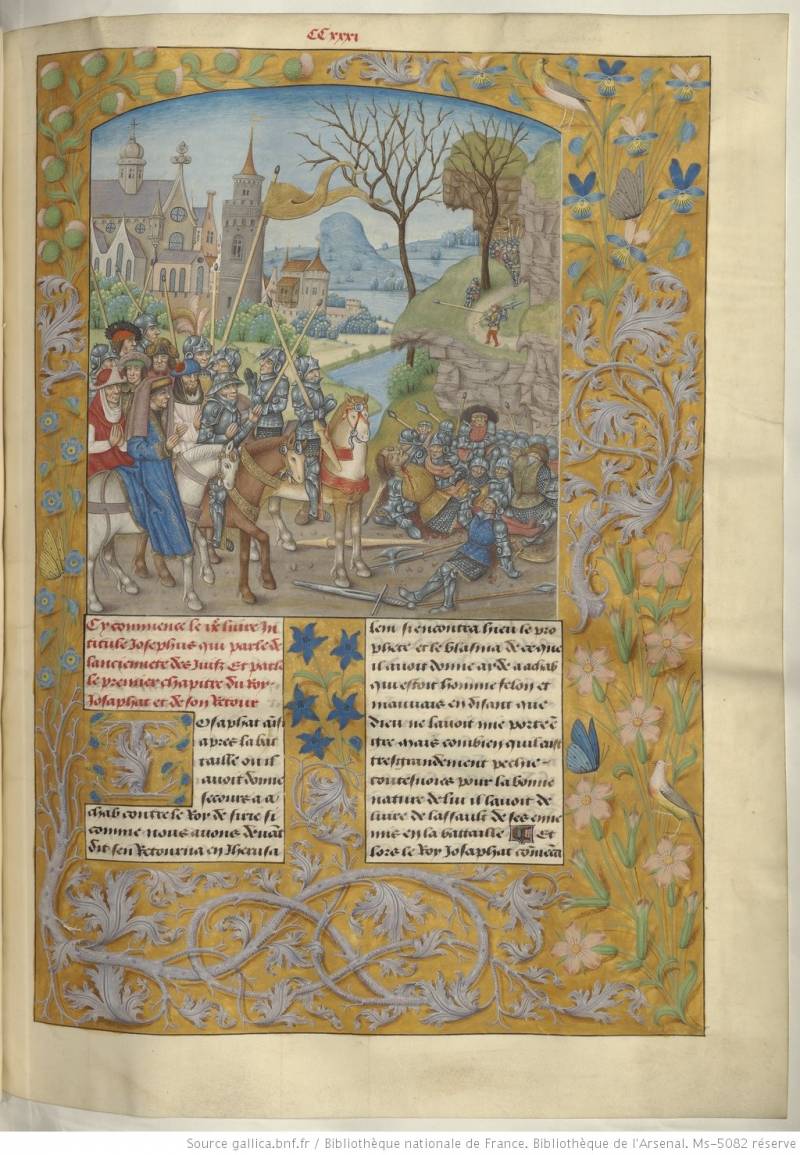
And here is the scene from the "Jewish War". But it is clear that the illustrator does not make a difference between the Roman soldiers and the equestrian men-at-arms of his day. It is interesting that the main helmet in the illustration is a sallet, and many riders have an additional cover on the visor - there are no finds of such helmets. The "chapelle de fer" depicts only one rider. No one has shields - the armor at the beginning of the XNUMXth century had already become so strong that they were abandoned. And very characteristic spears with an asymmetrical handle. Same source
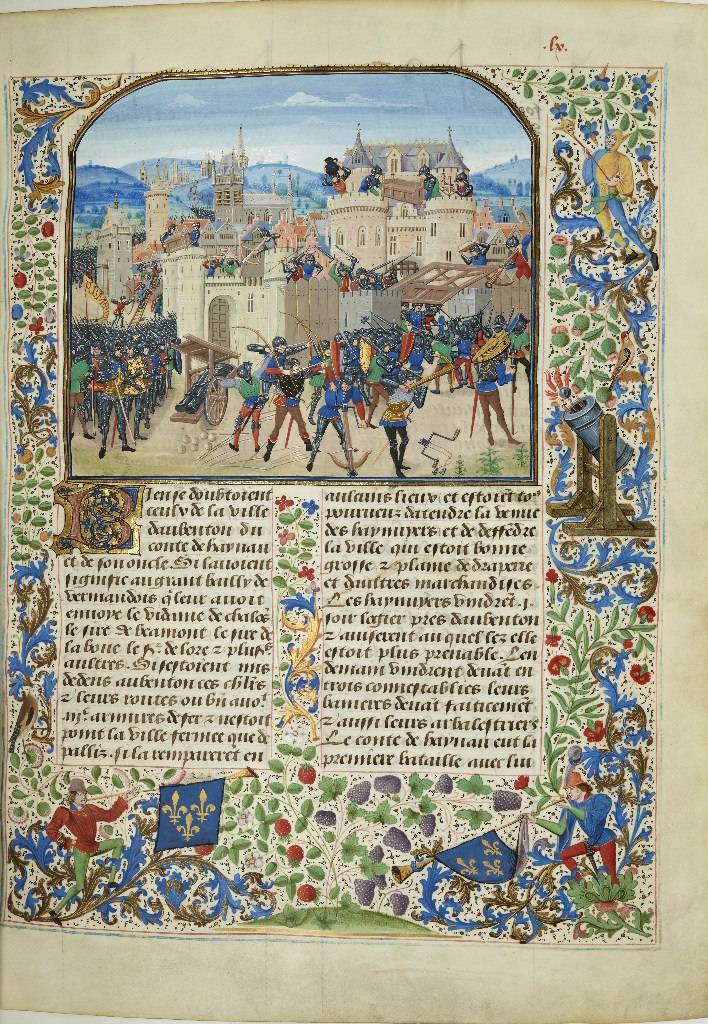
The design of the manuscripts, as you can see, at that time was very similar ...
So, what do the same miniatures by Froissart tell us, the design of which, as we have seen, is typical of the XNUMXth century, although they deal with events a hundred years ago? Let's take a look at them first...
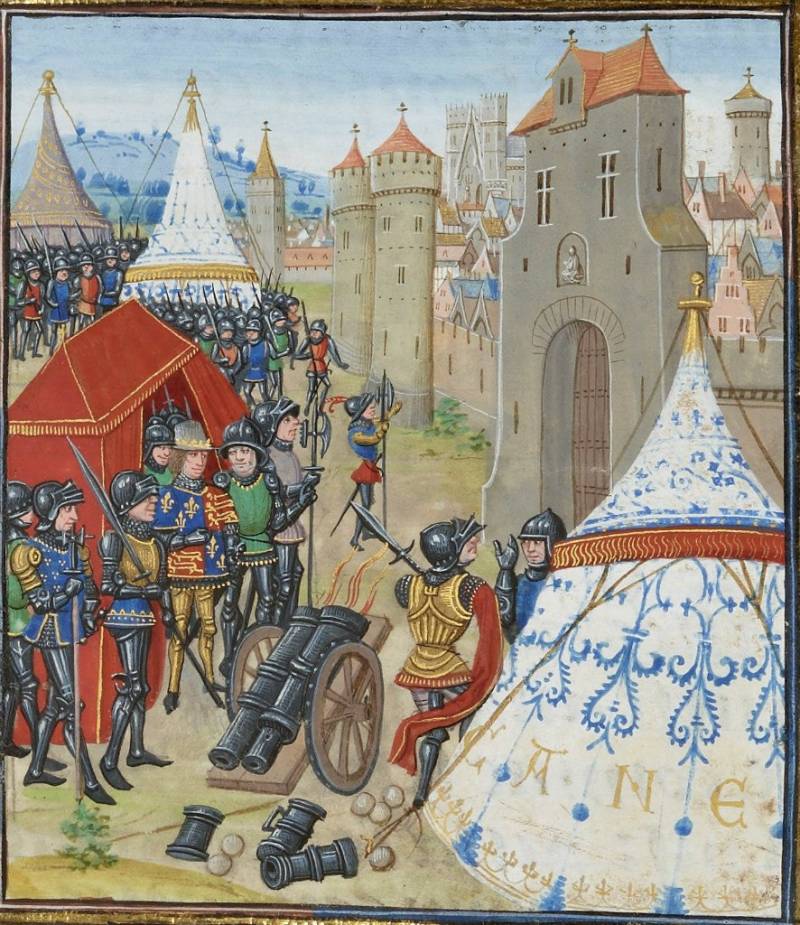
Here is the "Siege of Reims in 1359-1360 by Edward III" from the Chronicle of Froissart. First of all, jupons over armor and a variety of all kinds of polearms are striking. And also - a double-barreled gun with interchangeable chambers in the foreground. Miniature from the "Chronicles" by Jean Froissart, XV century. National Library of France
Battle of Poitiers, 1356. Archers against men at arms!
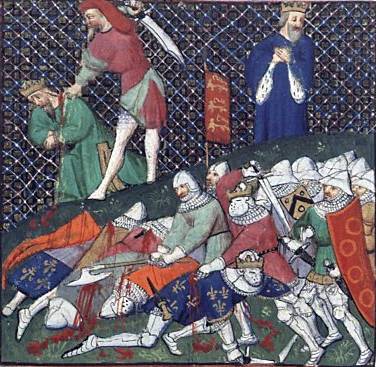
Different lists - different illustrators. Capture of John the Good at the Battle of Poitiers. Miniature from the "Chronicles" by Jean Froissart, XV century. National Library of France
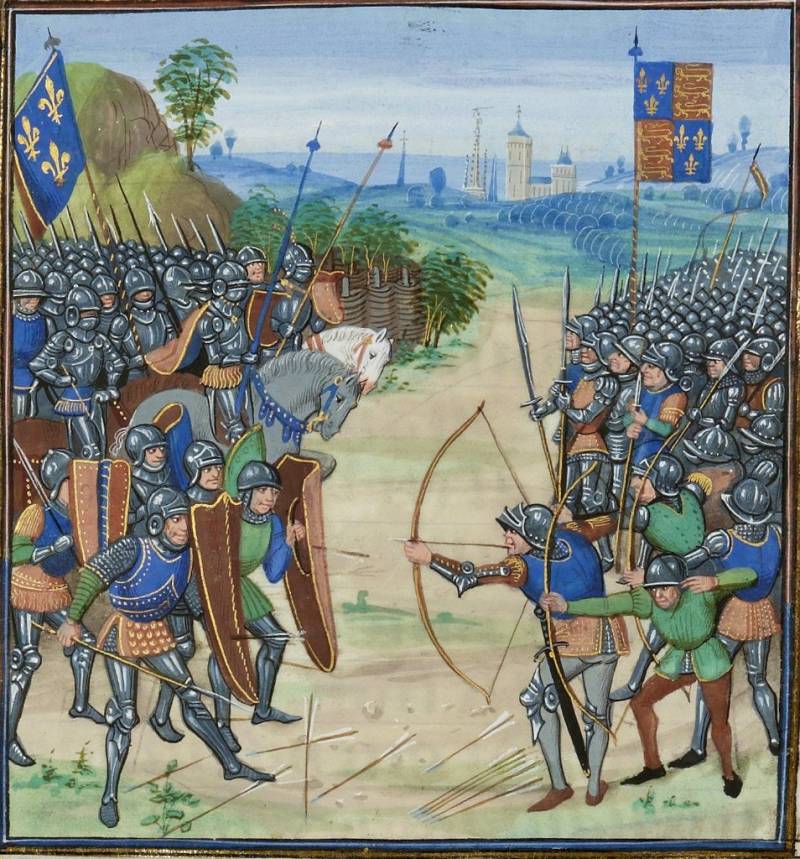
Battle of Saint Clement in 1358. Brigands - men-at-arms, dart throwers with paveses, against English archers
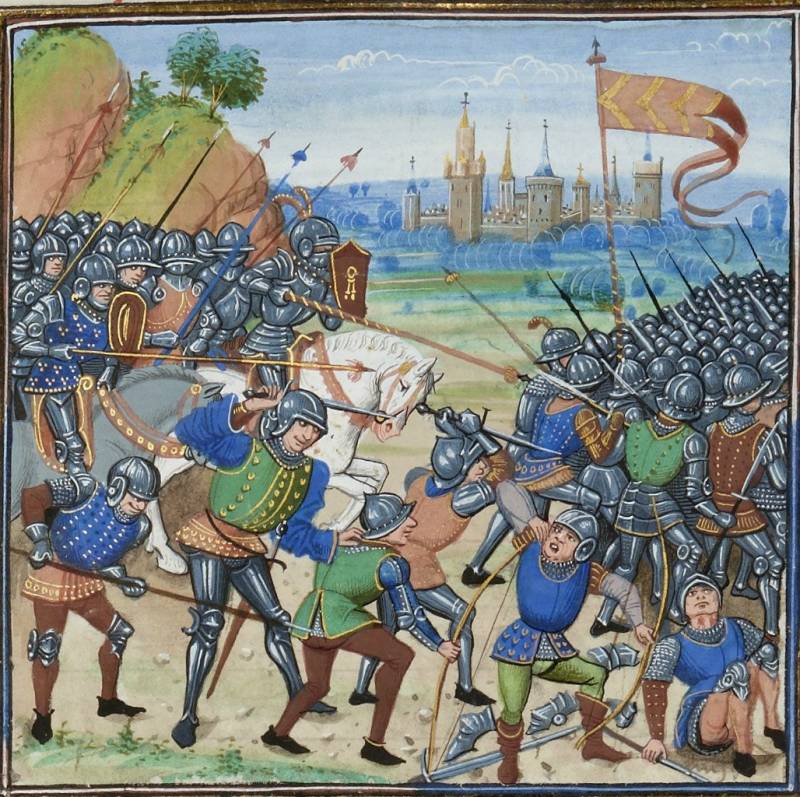
And here is the "Battle of Nogent-sur-Seine 1359 between the Bishop of Troyes and the combined troops of the British and Navarrese." The French on horseback attacked the English in three battles of 400 men each (a total of about 400 men at arms and 200 archers), but they, dismounting and shortening their spears to 5 feet, met with an impenetrable wall, besides, they were supported by archers. But then 900 foot brigands with strong pavises and darts approached the French, threw them at the archers and put them to flight, and then set to work on the infantry. The English fled, and the French cavalry rushed to pursue them. Everything is very accurate on the miniature, even the white suit of Brocard de Fenestrange's horse, who commanded the French cavalry
And now there are individual figures in close-up.
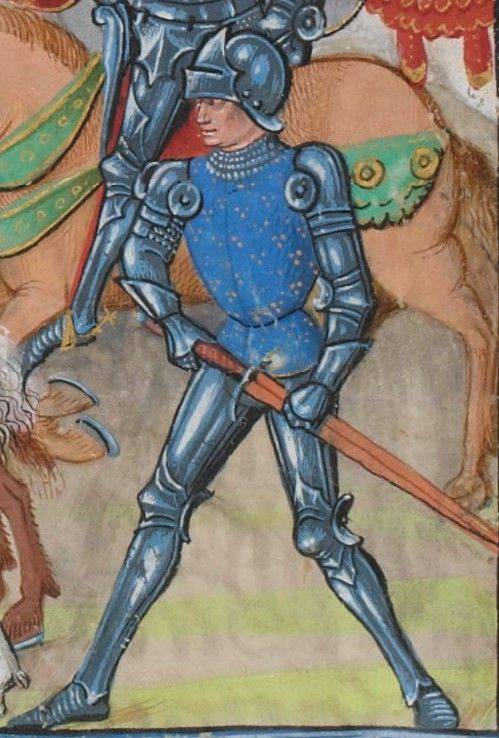
Here is the first of them - a typical French armor of the very beginning of the XNUMXth century - a sallet helmet with a forehead, a brigandine with rivet heads and rondels on the chest (we emphasize that the names of these parts of the armor are besagu, but round ones could be called that!)
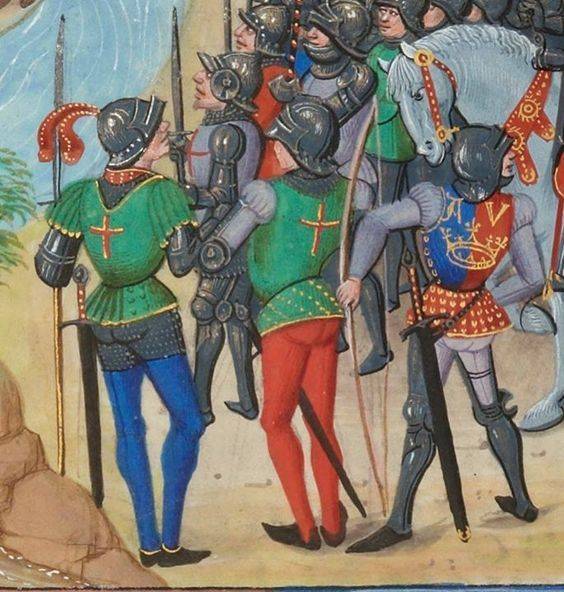
Mail underpants over chaises... funny!
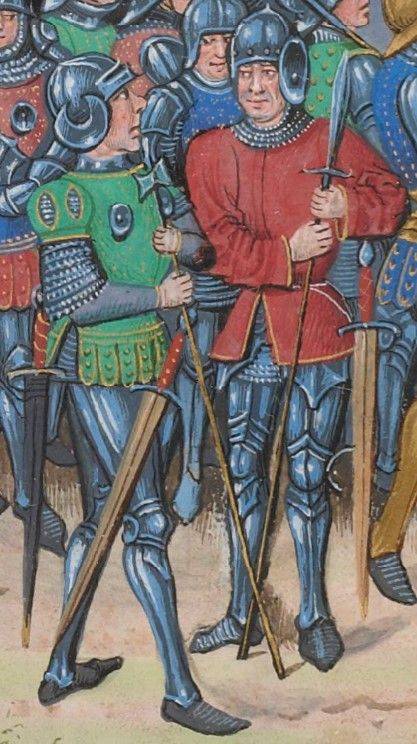
Two more at-arms 1401–1500 Both on that and on the armor, but the torso is covered with jupons, and on the fact that on the left it is also decorated with cuts on the sleeves, a split hem and badges sewn on the chest. The helmet is a sallet, but with headphones. Behind them are warriors dressed in brigandines, in a word - all this infantry is armed a little worse than the knightly cavalry! Well, swords - typical swords of this era with a piercing hardened blade of a rhombic section!
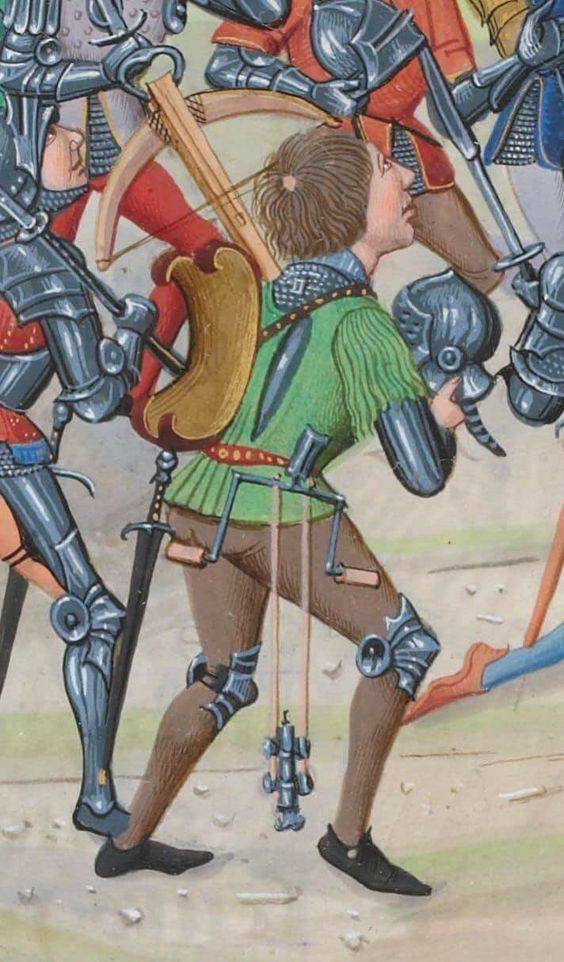
But this is a crossbowman, so he is wearing a little armor. However, he also has something metallic under his jacket, behind his back on a belt is a rather fantastic-looking shield, knee pads and a helmet - a French salad. The artist also depicted in detail the device hanging on his belt - the “English collar” for the crossbow. That is, at the time of illustrating this volume of "Chronicles" (1470), such "knobs" were still used by crossbowmen
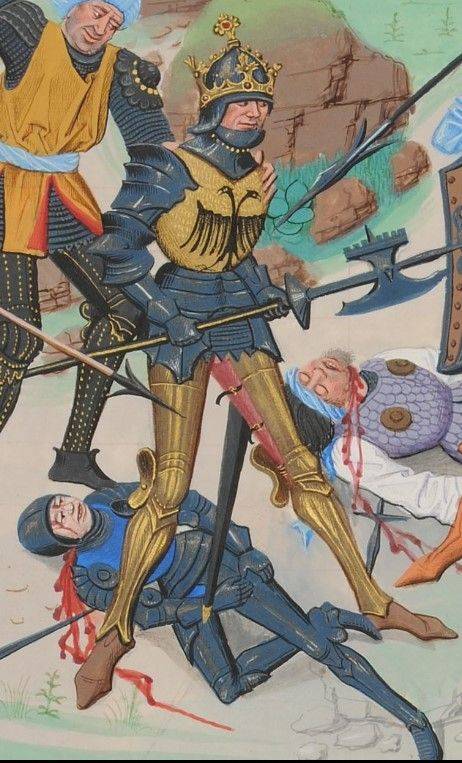
Again, for comparison, let's look at this fragment of a miniature from the Chronicle of Hainaut, an illustrated manuscript in three volumes that traces the history of the county of Hainaut up to the end of the 1446th century. Its text was written around 1450-1390 by Jean Vauquelin as a French translation of the Illustrated Annals of the County of Hainaut, a three-volume work in Latin written by Jacques de Guise around 1396-XNUMX. And again, if you do not know this, then you might think that this is ... a drawing from Froissart's manuscripts. The armor and weapons are well done. Moreover, the armor on Count Hainaut (in the center and in the bascinet with a crown) is clearly gilded. Royal Library of Belgium in Brussels
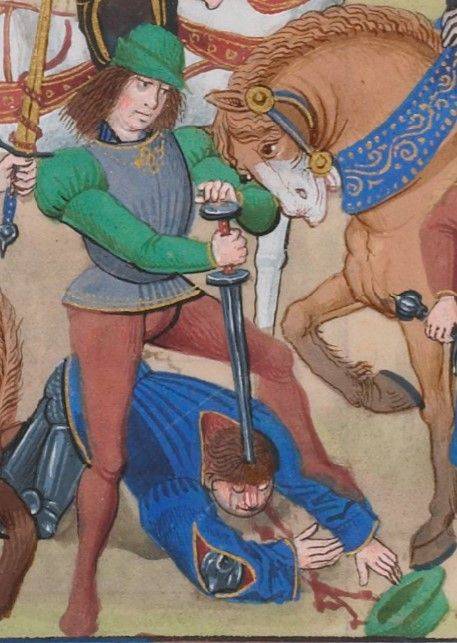
This illustration in Froissart's "Chronicle" just shows the use of a very large rondel dagger and what was sometimes hidden among the then warriors under their clothes made of fabric ...
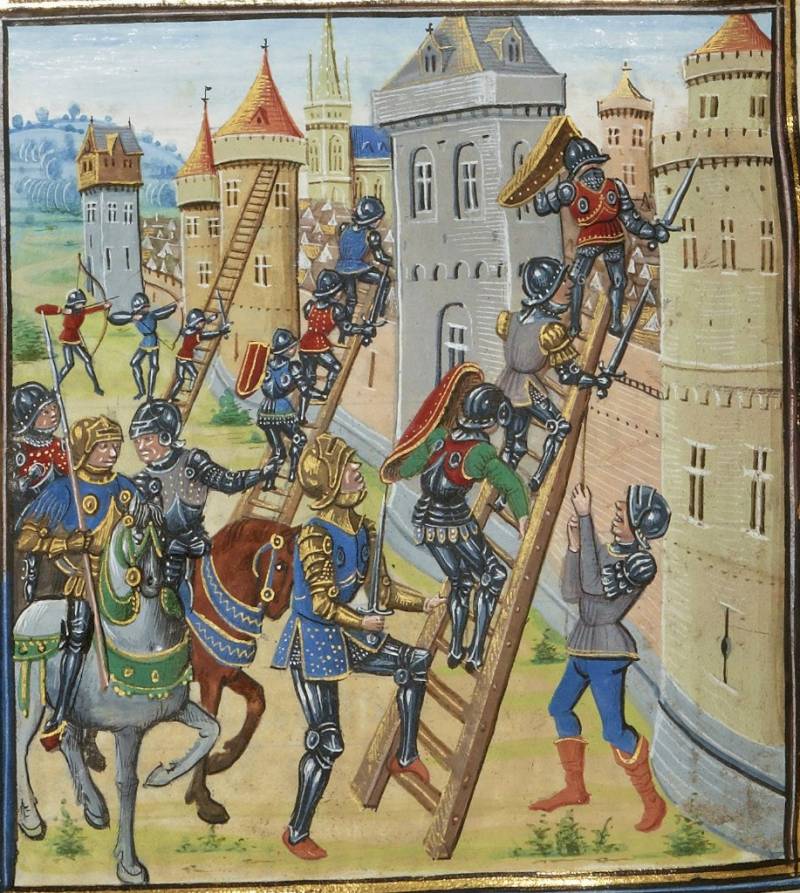
By the way, judging by the miniatures, the gilding of armor was quite widespread, and in the era of smooth armor it was one of the main forms of decoration. "The Capture of Châtellerault by the French in 1370" Miniature from Froissart's Chronicle
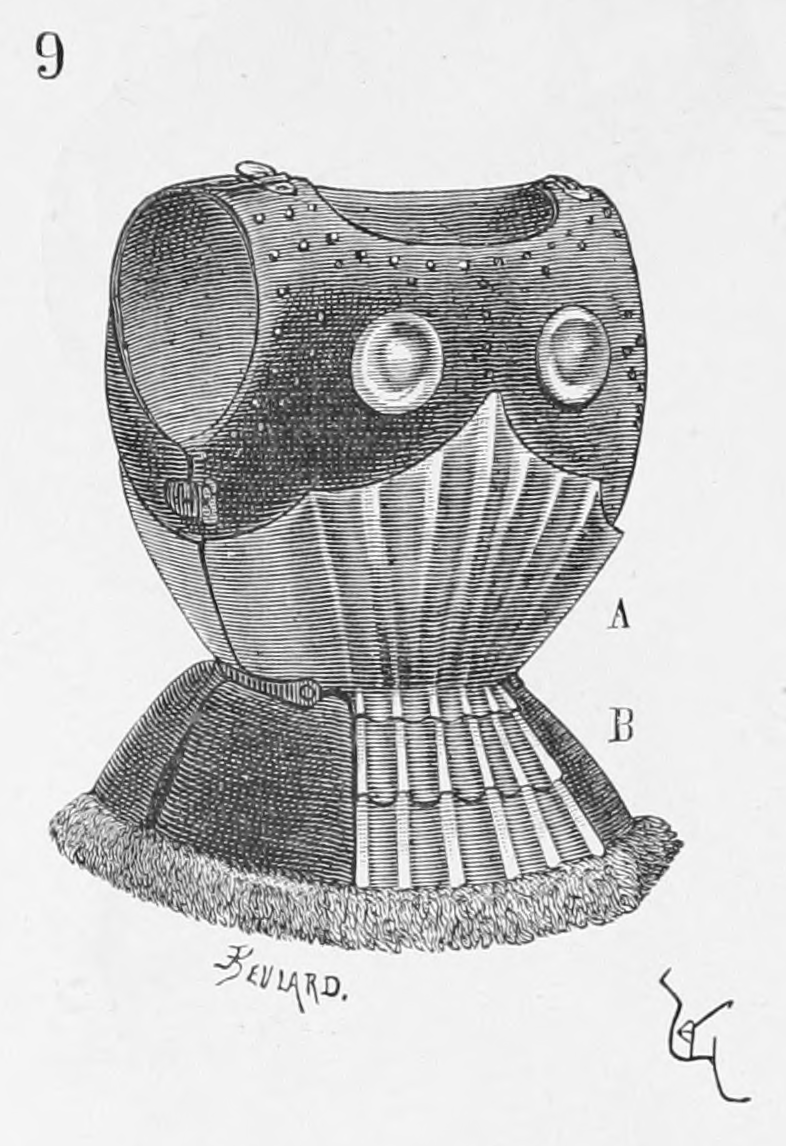
If you carefully examine the miniatures of those years, you can see a lot of curious armor. For example, this one: brigandine armor with a plate breastplate and a steel skirt - a redrawing from miniatures for the chronicles of Jean Froissart, ca. 1470 Illustration from Immanuel Viollet-le-Duc's book. National Library of France
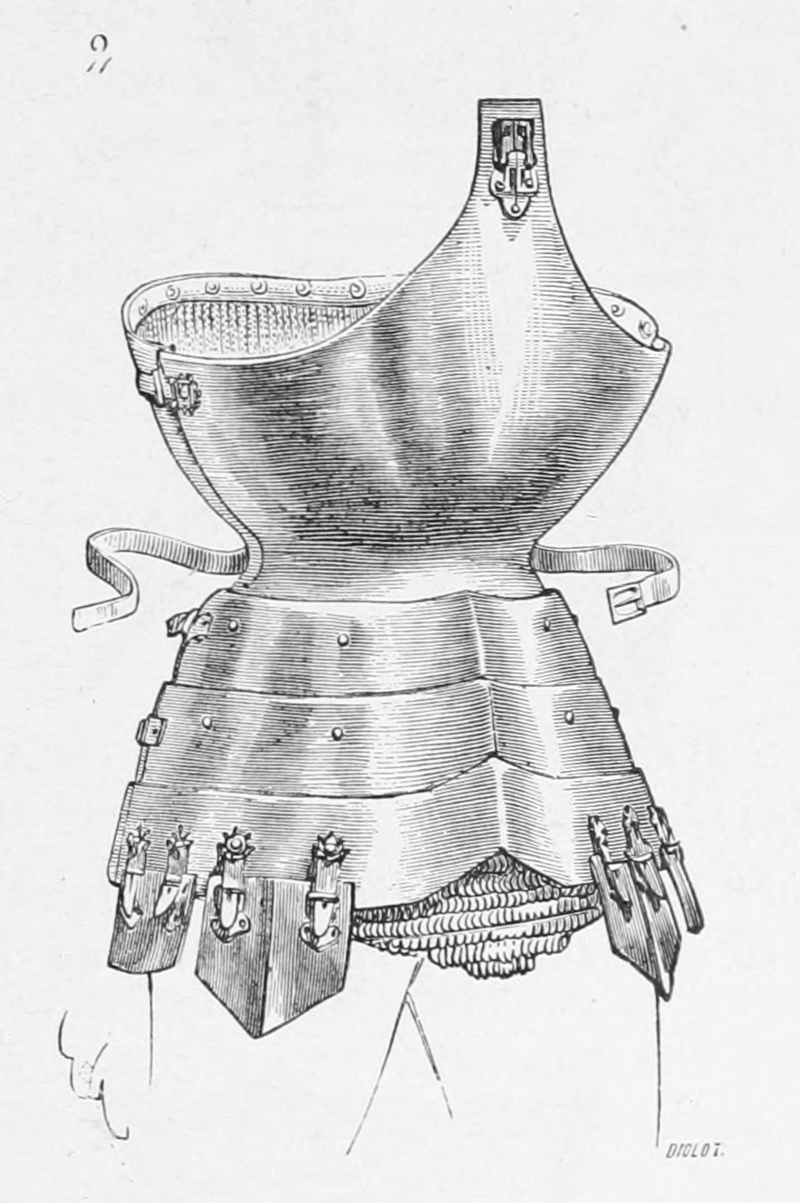
Another armor from the work of Viollet-le-Duc is a plate breastplate and a steel skirt. Illustration from the book by Immanuel Viollet-le-Duc. That is, the upper part of the cuirass in some cases could be missing and vice versa. That is, one set of armor, if desired, could be turned into two - for one warrior the top, the other - the bottom!
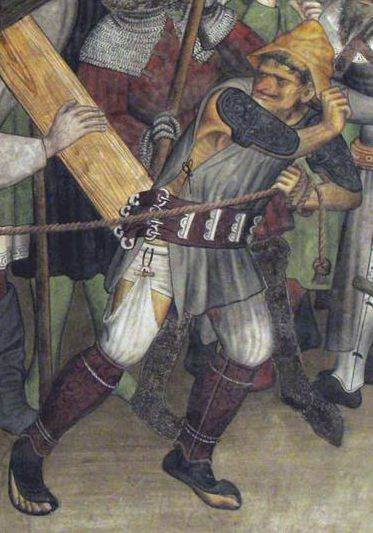
But more surprising than all the soldiers in leather bracers from Giacomo Jaquerio's book Ascending Calvary, ca. 1410. He does not wear a shirt, which is replaced by two pieces of fabric, or one piece with a hole for the head, tied on the sides with ropes. The stockings are attached to the shorts on strings with a wooden crutch. Below the knees, the legs are protected by leather greaves wrapped in ropes. The equipment is complemented by a chic leather combat belt, reinforced with four belts and metal plates. Since a mythical plot is depicted, it is obvious that the artist simply decided not to strain his imagination and depicted what he saw and what he was well aware of, because otherwise why would he need to draw all these little things? That is, in 1470, types dressed in this way met ...
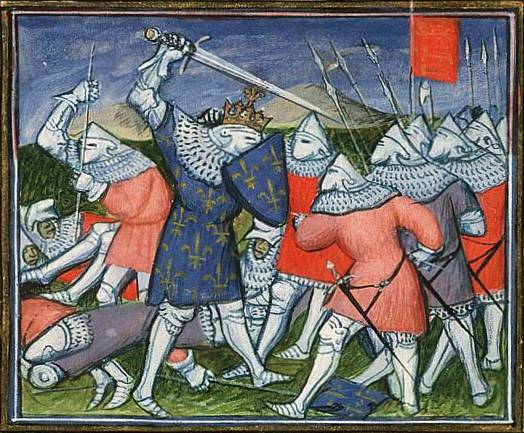
And this is how I designed the first volume of the "Chronicles" by Froissart "Master Virgil" "The Battle of Poitiers"
Information